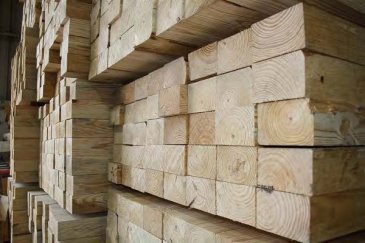AgEBB-MU CAFNR Extension
Green Horizons
Volume 23, Number 3
Fall 2019
Forest Industry
Missouri Hardwood Export Trade
By Lynn Barnickol | Missouri Consulting Foresters Association
Missouri hardwoods are an internationally traded, industrial raw material, manufactured from forests that are hopefully renewable. When global and domestic economies are strong everyone in the supply chain benefits. Domestically, the upper grades of hardwood lumber that's used in finished products are in demand depending on consumer's level of interest and strength of the US economy. Industrial hardwood products like railroad ties, crane mats, other timbers, and blocking not used in finished products are, at some level, usually in need. Pallet lumber and pallets are used domestically, but pallets are also exported, facilitating the shipping and handling process of various manufactured products. Sawmillers need markets for the heart center of good logs as its where the knots and other defects are located. If any clear wood is to be recovered from a plump log it's in the outer jacket of wood surrounding the heart center. That is where the opportunity for upper grades of hardwood lumber is found. Since the upper grades of lumber can be exported, as well as used domestically, it makes sense to have various domestic and international markets. Internationally, China has been a trading partner for many US goods including logs and the upper grades of red oak and walnut lumber. Trade with China peaked in 2017 when US wood exports topped $9.5 billion. China was at $3.2 billion or 33%; Canada at $2 billion or 20%; and the United Kingdom, Japan and Mexico at about 7% each; all totaling about 74% of the US wood export market. The remaining market share of 26% is split among all other countries*. The take home is that China receives about one-third of the of the US wood products exported. Zooming in to Missouri, a total of over $212 million in wood products were exported in 2017. Of that, China accounts for 40% of the value; Canada 11%; Spain, France, and Mexico account for about 5% each for a total of about 66% market share. The remaining 35% of the $212 million export value represents other countries. The top five products are walnut lumber and logs, white oak barrels, red and white oak lumber, and shortleaf pine lumber and eastern redcedar logs.*
 |
Missouri timber, Photo credit: Julie Harker, Brownfield Ag News |
While China was a major player importing significant amounts of hardwoods representing 45% of world marketshare for lumber and 57% of log exports; there are several other countries that import grade hardwood lumber and logs.** Restricted trade with China has not helped those in the hardwood lumber and log supply chain. Some bright spots: The Missouri Department of Agriculture Domestic and International Marketing Program, plus various lumber and log exporters, are attending trade shows in Vietnam, Taiwan, Dubai, and Brazil promoting Missouri hardwoods. Individual lumber and log producers have structured their business around the domestic market while others are seeking to widen their export opportunities. Finding new trading partners has drawbacks. Vietnam seeks hardwoods but its infrastructure is lacking, and the economies of some countries peak and wane causing an un-steady market. Problems with China have not helped and Missouri weather has slowed wood production. Best advice is to work with your forester, take advantage of professionally trained loggers, and be in contact with your tax accountant about revenue from timber harvesting. Take a look at the Bid Box: Quality hardwoods in commercial quantities always make a statement.
*Missouri Department of Ag and USDA 2017 GATS
**July 2019 American Hardwood Export Council Southeast Asia and Greater China
